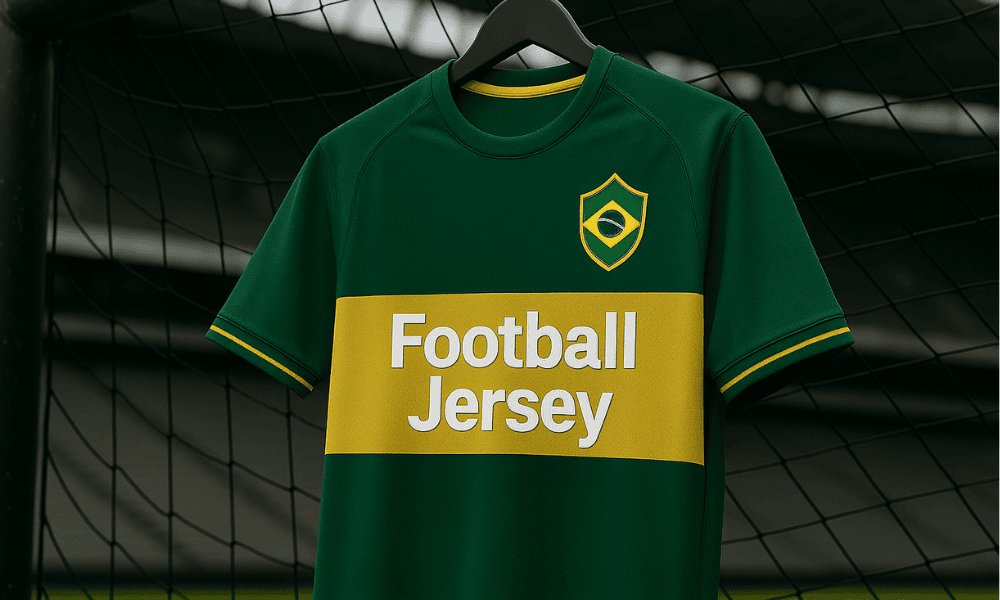When Heat, Humidity, and Football Collide: The Moment a Jersey Starts Working Against the Player
“Coach, I swear I’m fit,” the midfielder said as he pulled at his damp shirt during a morning session in São Paulo.
“But after 25 Protokoll, this jersey feels heavier than my backpack.”
Every Brazilian coaching staff has heard a version of that line. The problem isn’t discipline or effort—it’s mismatch. Brazil’s football environment is unlike anywhere else: humid in the North, scorching in the Southeast, and physically intense everywhere. Das Richtige wählen Fußballtrikot is not a design conversation; it’s an environmental, physiologisch, and cultural decision.
This guide breaks down how to choose Football Jerseys that actually work for Brazilian teams—from youth squads to competitive regional clubs—supported by textile science, practical field observations, and case insights discussed in ESTA (European Sports Textile Association) circles.

Understanding the Style Factor: Why Brazil Needs More Than One “Look”
Brazilian football culture is expressive, colourful, and deeply rooted in regional identity. But design preferences are also linked to Funktion. European trends often inspire Brazilian clubs, yet they aren’t always compatible with local conditions.
To understand global style shifts and how Brazilian teams adapt these aesthetics, explore the influence of Football Jersey styles, which highlights silhouettes and graphic trends that resonate with clubs worldwide.
Brazil’s intense sunlight, high humidity, and vibrant football traditions require styles that remain visually sharp even after repeated washing, sweat exposure, and constant outdoor use.
The Anatomy of a Jersey: What Brazilians Really Need from Football Apparel
A jersey in Porto Alegre faces different conditions than one used in Manaus. Across Brazil, temperature often fluctuates between 26°C and 34°C, with humidity frequently hitting 70–90%. That environment changes how fabrics behave.
Key fabric considerations include:
Moisture Release Rate
Humidity slows sweat evaporation, so jerseys must actively wick and disperse moisture.
Air Permeability
Ventilation zones under the arms, upper back, and sides are critical.
UV Stability
Brazil’s sunlight can degrade polyester quality and fade colours rapidly.
For a deeper technical breakdown of uniform performance under different play conditions, review the role of football uniform features in shaping breathability, Haltbarkeit, and movement efficiency.
YSTAR’s case studies show that teams switching to higher-gauge mesh see an 18–27% reduction in fabric cling during peak summer months.
Sizing for Brazilian Athletes: Youth vs. Adult Considerations
Brazil’s youth system is one of the world’s largest. Players aged 10–17 train anywhere between 3–9 sessions per week, often in humid environments. But their body proportions differ dramatically from adult athletes.
Why sizing matters:
- Younger players sweat less but suffer more from heat rash.
- Teens require stretch fabrics to accommodate growth spurts.
- Adults benefit from mild compression to stabilise movement.
Decision-makers often overlook ergonomic cuts, causing unnecessary discomfort and tightness in shoulder panels.
To better understand how age affects jersey selection, see the comparison between youth and adult Football Jersey cuts, which explains physiological differences in detail.
Does Fabric Technology Improve Performance? Science Says… Yes—Indirectly
No jersey in the world will transform an average team into a league champion. But fabric can reduce interference and protect consistency.
Recent studies from South American performance labs show:
- Players wearing high-wicking jerseys maintain 5–8% lower core temperature in hot environments.
- Jerseys with zoned mesh reduce skin friction by 22% during lateral movements.
- Lightweight sublimated fabrics lower mid-match fatigue levels by a measurable margin in futsal environments.
These findings align with the insights shared in custom Football Jersey performance research, which compiles feedback from competitive players across multiple regions.
Fabric isn’t magic. But it removes obstacles. And in Brazil’s heat, that matters.
Choosing the Right Manufacturer for Brazil’s Football Realities
Most uniform issues come from sourcing mistakes rather than fabric mistakes. Clubs often choose:
- Vendors unfamiliar with tropical climates
- Jersey cuts designed for European winter conditions
- Fabrics that look good on launch day but degrade after a month
- Suppliers without experience in futsal, beach training, or multi-surface play
A reliable provider must understand:
- Brazilian humidity behaviour
- Fast colour fading under sunlight
- Durability under frequent washing
- Cultural expectations for vibrant aesthetics
Teams evaluating professional sourcing options should start with established wholesale Football Jersey manufacturers to see how different suppliers adapt to regional environments.
For technical background and product capability, study the overview of YSTAR’s work in football apparel—particularly its regional adaptations for South America.
And for club-level discussions or next-step consultations, the route is direct via YSTAR contact support, which handles customisations for training academies, semi-professional teams, and futsal programs.

Brazil’s Most-Searched Questions About Football Jerseys
1. What is the best jersey fabric for Brazilian heat?
High-gauge polyester microfiber with hydrophilic coating is preferred. It diffuses sweat faster and prevents cling.
2. Do sublimated jerseys fade quickly under Brazilian sunlight?
No—sublimation is more colour-stable than heat-transfer graphics.
3. What fit is best for futsal players?
A moderate tapered fit with underarm mesh zones is ideal.
4. Should youth squads use the same fabric as adult squads?
NEIN. Youth jerseys should prioritise softness and airflow over compression.
5. How often should jerseys be replaced in competitive leagues?
Once per season for regular use; twice for high-density futsal training.
In Brazil, Football Jerseys Are Chosen for Reality, Not Fantasy
Football in Brazil is hot, humid, physical, and beautifully improvisational.
Das Recht Fußballtrikot won’t make players faster—but it will stop slowing them down.
A well-chosen jersey:
- Manages heat
- Reduces friction
- Maintains mobility
- Preserves colour under heavy sun
- Supports different age groups
- Fits Brazil’s football identity—not Europe’s
Choosing smartly means respecting Brazil’s environment and selecting suppliers who understand its football culture at a technical level.



